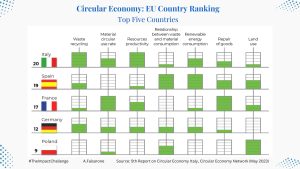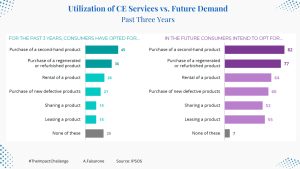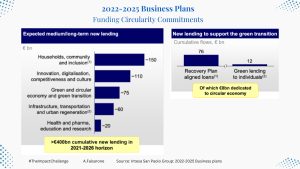NEWSLETTER by Alessia Falsarone
We have heard it loud and clear: despite some progress in circularity, the EU economy is still mainly linear. Sectors that have embraced circularity have experienced growth in innovations, private investment, and employment. However, the real challenge is how to elevate early circularity efforts and ensure they make direct and measurable contributions to advancing climate neutrality and fostering socio-economic resilience within the EU bloc. Building governance practices that promote collaboration and accountability may soon become the secret recipe to achieve success. This journey has already started in Italy.
| The Science of Impact
With the recent release of an updated monitoring framework to track the transition to a circular economy (CE), the European Commission has introduced new indicators to measure progress in areas like material footprint and waste prevention. Its focus is clear: reducing material consumption is key to achieving a more circular economy in the EU. While production has become more resource-efficient, the datashow that EU consumption of materials remains high and must decrease over time. What’s even more insightful is that, geopolitical factors such as material imports dependency and EU self-sufficiency for critical raw materials have now officially entered the framework and its broader narrative.
Despite increasing adoption and integration of circular approaches in laws and policies, businesses are far from realizing lasting commercial wins due to the CE. Narrow knowledge of legal structures that support business experimentation with circular economy policies, keeps hindering their implementation.
In my program at the University of Chicago, we have spent quite some time testing few structural elements that make governing a circular economic system effective through time, including:
〉the leadership of government (public governance);
〉the continued and active involvement of stakeholdersin both private and public sector (engagement), and
〉the evolution and legal support to circular business models towards a network of collaborators (network governance).
I find the evidence introduced by Jacqueline Cramer, senior advisor at the Copernicus Institute of Sustainable Development, Utrecht University, quite compelling to evaluate the effectiveness of governance practices for country-level transitions towards a CE:
 >>click to zoom in | Credit to Cramer, J., Journal of Cleaner Production, Vol 343, 2022, ISSN 0959-6526, https://doi.org/10.1016/j.
>>click to zoom in | Credit to Cramer, J., Journal of Cleaner Production, Vol 343, 2022, ISSN 0959-6526, https://doi.org/10.1016/j.
After successfully establishing circular initiatives, the challenge is to expand and increase participation among stakeholders. Ambitious scaling requires a clear goal orientation throughout the network, and government leadership is essential at this stage. Each country faces unique challenges in implementing public and network governance and mobilizing drivers for change. Effective governance is achieved by aligning CE strategies with the country’s early window of opportunity that only transparent government policies can afford.
| Circularity Roadmaps Explained
An example of implementing CE practices at the country level, in a bottom-up fashion, is seen in Italy. Prof. Cramer’s comparison of Italy to other geographies like Scotland, Taiwan, and northern EU countries, highlights Italy’s governance approach to circularity as:
〉Government CE leadership: strong.
〉Involvement industry: medium/high.
〉Network governance: medium/high
Italy has maintained its position as Europe’s top circular economy, followed by Spain, France, Germany, and Poland, according to a recent report by the Circular Economy Network (CEN) and the Italian National Agency for New Technologies, Energy, and Sustainable Economic Development (ENEA). The report evaluates the top five EU economies based on seven indicators related to material and product reuse and regeneration, including recycling rates, use of recycled material, resource productivity, waste generation, renewable energy consumption, repair rates, and land use.
 >>click to zoom in | Credit to 5th Report on Circular Economy Italy, Circular Economy Network (May 2023)
>>click to zoom in | Credit to 5th Report on Circular Economy Italy, Circular Economy Network (May 2023)
A basic question that the survey explores is the following:
Is consumer awareness linked to the uptick in circularity performance for Italy?
In the appendix study conducted by market research provider Ipsos, it was found that the inclination towards more circular consumption patterns is increasing among Italians. Specifically, 45% of Italians participating in the research purchased a used product and 36% opted for reconditioned or remanufactured products in the past 3 years. No surprise, as Italians tend to rent or share motorcycles and cars, and buy second-hand clothing, accessories, and regenerated technological products.
 >>click to zoom in |Credit to market research provider IPSOS
>>click to zoom in |Credit to market research provider IPSOS
In the 18-30 age group – for which the use of leasing, renting, and sharing as circular consumer modalities is above average – the Ipsos study paradoxically finds that this group is most skeptical about proposals to incentivize a more circular approach to purchasing decisions and has little confidence in the industry’s ability to improve governance in this area. A non-trivial data point for the strengthen the uptick in circularity supported by both stakeholder collaboration and adherence to a sound network governance practices.
| Investing in the Circular Economy
Private sector investments in the circular economy amounted to over EUR 121 billion in 2021, equivalent to roughly 1% of the EU’s GDP. Specifically, the banking sector has played a major role in promoting circularity principles and acting as strategic partner and innovation funding source to SMEs embarking on the circularity transition.
Intesa Sanpaolo Group is one such Italian banking institution that has integrated circular economy objectives into its business plans and has been channeling investments into the country’s circular innovation network, including the redesign of its industrial ecosystem.
The Group highlighted some interesting metrics on its expanded loan underwriting capacity targeting circularity initiatives in 2022. These include:
〉out of 430 circular innovation projects (*) analyzed, 420 got funded for a total of EUR 9.0 billion
〉additional EUR 2 billion circularity loans were disbursed as green financing
〉priority given also to projects enabling sustainability solutions at the national level, such as the topic of Circular Water.
 >>click to zoom in | Source: https://group.intesasanpaolo.
>>click to zoom in | Source: https://group.intesasanpaolo.
Note (*): CE criteria are defined by the team at Intesa together with the Ellen MacArthur Foundation.
Not surprisingly, significant efforts on enabling CE target setting are likely to become part of the United Nations Environment Programme Finance Initiative (UNEP FI)’s Principles for Responsible Banking 2.0.
| You don’t want to miss this week
From Dublin, to greater Helsinki, and Chicago, this week offers new opportunities to connect with fellow circularity practitioners both in person and in hybrid mode.
Discover, grow and leave your mark!
〉May 29th – June 1st: Circular Economy Hotspot 2023(Dublin, Ireland). A four-day celebration of the circular economy, through conference talks, tours, workshops and topic deep-dives. Attendees will learn about the practical steps and resources to take home and implement such as new business models or innovations that could shape the future of work and lifestyle.
〉May 31st – June 2nd: PLATE Conference 2023. (Aalto University, Finland). The 5th PLATE (Product Lifetimes and the Environment) Conference addresses product lifetimes in the context of sustainability. Notable keynotes include Susanna Horn, group manager in the industry and value chains at the Finnish Environment Institute (Syke) – Suomen ympäristökeskus (Syke) – who will discuss how product lifetimes have been framed in the context of the circular economy and the impact of the recent proposal for Eco-design for Sustainable Products Regulation (ESPR). Nina Teufel (Ludwig), adidas’ Innovation Manager will share her involvement in the New Cotton Project.
〉June 1st: Accelerating the transition towards a circular built environment (Hybrid, Helsinki). Hosted by the Circular Buildings Coalition, this accelerator-style event aims to provide insights on the European construction industry’s carbon budget, financing for circular buildings, and emerging business models. It will also focus on identifying effective strategies to scale-up and replicate solutions that address systemic barriers, emphasizing the crucial role that cities must play in driving this transformation.
Join us at UChicago Circular Economy and Sustainable Business
On June 1st we will be welcoming Maureen Kline, Vice President of Public Affairs and Sustainability at Pirelli Tire North America, to our practitioner series. With a career spanning both sides of the Atlantic, Maureen has continued to grow her invaluable perspective on the industry’s circularity efforts by serving on the board of the U.S. Tire Manufacturers Association and of the Tire and Rubber Association of Canada.
| All opinions expressed are those of the author and/or quoted sources. investESG.eu is an independent and neutral platform dedicated to generating debate around ESG investing topics.












